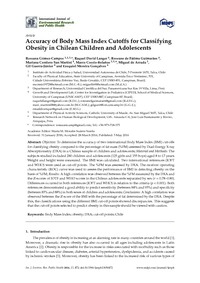Mostrar el registro sencillo de la publicación
Accuracy of body mass index cutoffs for classifying obesity in chilean children and adolescents
| dc.contributor.author | Cossio-Bolaños, Marco Antonio | |
| dc.contributor.author | Gómez-Campos, Rossana | |
| dc.contributor.author | David-Langer, Raquel | |
| dc.contributor.author | Contiero-San Martini, Mariana | |
| dc.contributor.author | Fátima-Guimarães, Roseane de | |
| dc.contributor.author | Guerra-Júnior, Gil | |
| dc.contributor.author | Moreira-Gonçalves, Ezequiel | |
| dc.contributor.author | De Arruda, Miguel | |
| dc.date.accessioned | 2017-10-04T15:23:12Z | |
| dc.date.available | 2017-10-04T15:23:12Z | |
| dc.date.issued | 2016 | |
| dc.identifier.uri | http://repositorio.ucm.cl/handle/ucm/323 | |
| dc.description.abstract | Objective: To determine the accuracy of two international Body Mass Index (BMI) cut-offs for classifying obesity compared to the percentage of fat mass (%FM) assessed by Dual-Energy X-ray Absorptiometry (DXA) in a Chilean sample of children and adolescents; Material and Methods: The subjects studied included 280 children and adolescents (125 girls and 155 boys) aged 8 to 17 years. Weight and height were measured. The BMI was calculated. Two international references (IOFT and WHO) were used as cut-off points. The %FM was assessed by DXA. The receiver operating characteristic (ROC) curve was used to assess the performance of BMI in detecting obesity on the basis of %FM; Results: A high correlation was observed between the %FM measured by the DXA and the Z-scores of IOTF and WHO scores in the Chilean adolescents separated by sex (r = 0.78–0.80). Differences occurred in both references (IOFT and WHO) in relation to the criteria (p < 0.001). Both references demonstrated a good ability to predict sensitivity (between 84% and 93%) and specificity (between 83% and 88%) in both sexes of children and adolescents; Conclusions: A high correlation was observed between the Z-score of the BMI with the percentage of fat determined by the DXA. Despite this, the classifications using the different BMI cut-off points showed discrepancies. This suggests that the cut-off points selected to predict obesity in this sample should be viewed with caution. | es_CL |
| dc.language.iso | en | es_CL |
| dc.rights | Atribución-NoComercial-SinDerivadas 3.0 Chile | * |
| dc.rights.uri | http://creativecommons.org/licenses/by-nc-nd/3.0/cl/ | * |
| dc.source | International Journal of Environmental Research and Public Health, 13(5), 472 | es_CL |
| dc.subject | Body mass index | es_CL |
| dc.subject | Obesity | es_CL |
| dc.subject | DXA | es_CL |
| dc.subject | Cut-off points | es_CL |
| dc.subject | Chile | es_CL |
| dc.title | Accuracy of body mass index cutoffs for classifying obesity in chilean children and adolescents | es_CL |
| dc.type | Article | es_CL |
| dc.ucm.facultad | Facultad de Ciencias de la Educación | es_CL |
| dc.ucm.indexacion | Scopus | es_CL |
| dc.ucm.indexacion | Isi | es_CL |
| dc.ucm.doi | doi.org/10.3390/ijerph13050472 | es_CL |



